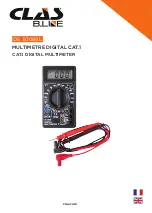
6
2. DC or AC Voltage Measurement
•. To avoid harms to you or damages to the Meter from electric shock, please do not attempt to measure voltages higher than 1000 V although
reading may be obtained!
•. The Meter has an input impedance of 10MΩ
,
This loading effect can cause measurement errors in high impedance circuits and so you need to
take a note on it.
3. DC or AC Current Measurement
•. Before connect the Meter in serial with the tested return circuit, closed
the return circuit current to avoid the dangerous of sparking.
•. Do not use over
>
10A current measurement ! Although the meter can work on below 20A current testing but for the avoiding any harms to you or
damages to the Meter !
4. Measuring Resistance, Diodes, Continuity or Capacitance
•. To maintain the measurement accuracy, discount circuit power and discharge all the high voltage capacitors during the measuring resistance.
•. When measuring high resistance on 1MΩ or above, it is normal to take several seconds to obtain a stable reading. In order to obtain
stable reading, choose shorter test lead to carrying out measurement.
•. The test leads and the Meter inside wire will bring around 0.1Ω to 0.2Ω of error to resistance measurement when measuring low resistance. To
obtain accurate readings in low-resistance, short –circuit the test leads beforehand and record the reading obtained, call this reading as X. Then
use the equation: measured resistance value (Y) – (X) = accurate readings of resistance.
•. During measurement
,
Diodes is in a good silicon junction drops between 500mV to 800mV as the normal value
;
The continuity
measurement, the poles between resistance is >100Ω
,
it is a short circuit
,
but on the poles between resistance is ≤10Ω
,
it is a good
connection
,
buzzer is continually beep on
,
and the reading value is nearly to the circuit resistance value
,
Unit is Ω.
Accuracy Specifications
Accuracy
:
±(% r digits)
,
guarantee for 1 year
Operating temperature
:
18 to 28
℃
Environmental humidity
:
Less than 75%RH
72-14615 Operating Manual































